Is a suture kit essential for survival in 2023? Medical students, of course, know all about suturing: they learn suture techniques thoroughly and can handle any wounds easily. The suture skill can come in handy if you get injured far away from civilization. In this case, the only thing that can save your life is stitching your wounds using items from your first-aid kit and your knowledge. Read the article and find out surgical techniques and devices that can save your life in any survival situation.
Top 5 Best Suture Kits
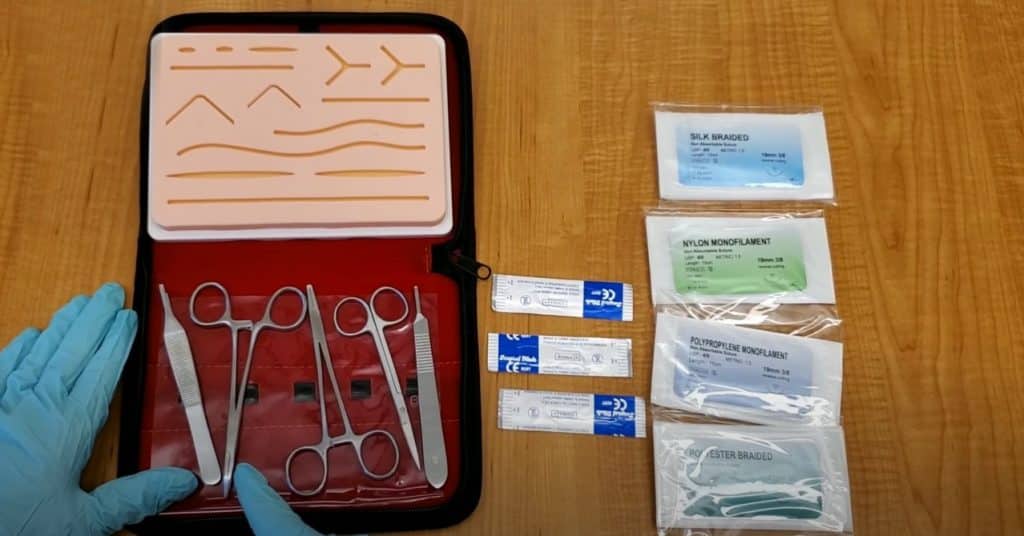
So when we were researching the market, we ensured that only the top products would hit our list.
5 – Your Design Medical Suture Accessories
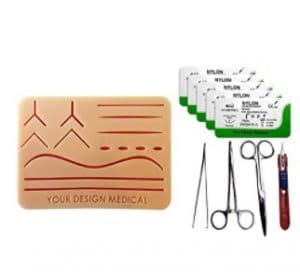
- A scalpel;
- Nylon sutures;
- Forceps;
- Scissor;
- A needle driver.
A customer will also find a silicone suture pad that provides quality human tissue simulation to perform suture practice during free time. This kit is perfect for hikers, survivalists, and medical students as well.
Features:
- Compact design suitable for portability.
- Silicone suture pad for realistic practice.
- Basic tools included for a comprehensive suturing experience.
Benefits:
- Ideal for hikers, survivalists, and medical students due to its compact nature.
- The silicone pad provides a realistic feel, mimicking human skin, aiding in effective practice.
- Equipped with essential tools, eliminating the need to purchase additional items.
Potential Drawbacks:
- Might not be as comprehensive as some other kits in terms of variety of tools.
- The compact size might compromise on the quantity of tools or materials provided.
User Reviews and Feedback
Review by Alex M., Medical Student:
“I purchased the Your Design Medical Suture Accessories kit as a supplementary tool for my medical studies. The silicone pad feels incredibly realistic, and the compact design is perfect for on-the-go practice. Highly recommended for fellow students!”
Feedback from Sarah L., Hiker:
“I always carry this kit during my hiking trips. It’s compact and has all the essential tools I might need in case of emergencies.”
4 – Suture Syringe Medic First Aid Kit
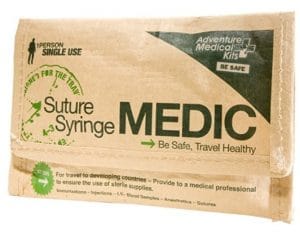
- Needles of three different sizes;
- Several syringes;
- A catheter;
- Medical gloves;
- Alcohol swabs and antiseptic wipes.
There is no suture pad, so you will not be able to use this pack as a suture practice kit, but it will surely become a great item for your bug-out-bag, as well as a get-home bag. Get a few of these kits and have one of the kits in your everyday carry case at all times.
While not the best of what the market may offer, Suture Syringe Kit definitely deserves its place in every prepper’s first aid stock.
Features:
- Compact and lightweight design.
- Focuses on emergency suturing without a practice pad.
Benefits:
- Highly portable, making it a great addition to emergency bags.
- Directly addresses emergency suturing needs without the distraction of practice materials.
Potential Drawbacks:
- Lacks a practice pad, which might be essential for beginners.
- Might not be suitable for those looking for a comprehensive learning experience.
User Reviews and Feedback
Review by Dr. Jonathan K.: “As a practicing physician, I find the Suture Syringe Medic First Aid Kit to be a valuable addition to my emergency bag. It’s straightforward and focuses on what’s essential.”
Feedback from Emily R., Traveler: “This kit is a lifesaver! I had a minor accident during my trip to the mountains, and this kit had everything I needed.”
3 – Matrix Mixed Sterile Suture Kit
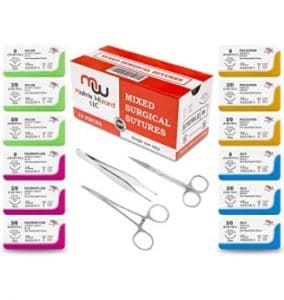
Again, this suture pack cannot be used as a suture practice kit since it has no skin pad, so medical students will most probably pass. But as for regular customers interested in having a decent suture kit in their first aid stocks, this Matrix Wizard’s kit is just fine.
Features:
- Basic suture kit without a practice pad.
- Sterile tools and materials.
Benefits:
- Sterility ensures safe and hygienic suturing, especially in emergency situations.
- Simplistic design makes it user-friendly and straightforward.
Potential Drawbacks:
- Absence of a practice pad might deter beginners or learners.
- Might not offer a wide variety of tools compared to other kits.
User Reviews and Feedback
Review by Nurse Clara B.: “The sterility of the Matrix Mixed Kit gives me peace of mind, especially when dealing with open wounds. It’s basic but does the job well.”
Feedback from Leo T., Survivalist: “Great kit for its price. It’s simple and effective, especially when you need to act fast.”
2 – Meditraining 32 Piece Suture Kit
This awesome suture kit packs thirty-two pieces and makes for a great buy for everyday users and medical students. This kit includes:
- Ten scalpel blades & a plastic handle scalpel;
- Scissors and forceps;
- Two needle-drivers;
- Twelve sutures with needles;
- Gloves;
- A carry case.
Plus, there is also a skin pad that realistically imitates skin layers, which makes this kit a perfect practice kit. Without a doubt, this suture kit is a must-have for medical students and survival enthusiasts.
Features:
- Comprehensive kit with a wide variety of tools.
- Includes a skin pad for realistic practice.
Benefits:
- 32 pieces ensure a thorough suturing experience, catering to various needs.
- The skin pad enhances the learning experience, offering a realistic feel.
Potential Drawbacks:
- Might be overwhelming for beginners due to the extensive range of tools.
- Could be bulkier compared to more compact kits, affecting portability.
User Reviews and Feedback
Review by Dr. Isabella G., Surgeon: “The Meditraining kit is comprehensive and perfect for refining suturing skills. The variety of tools provided is impressive.”
Feedback from Jake N., Medical Student: “As a student, practicing on the skin pad has been invaluable. It’s as close to the real thing as it gets.”
1 – MyMedic Suture, “The Stitch Kit.”
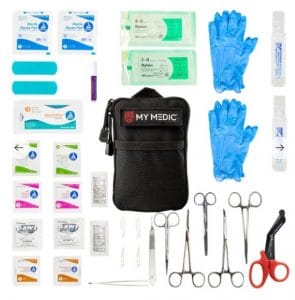
But if you are up for an ultimate suture kit, then “The Stitch Kit” by MyMedic kit is just what you’ve been looking for!
This kit has everything you will ever need to treat skin wounds. Sterilizing and sanitizing, suturing and dressing – you name it. With this kit and some decent skills of your own to go with it, you are ready to take any challenge in suturing cuts and lacerations.
This kit has the most impressive set of instruments on the market, from scalpels to EMP shears, from gloves to hemostats, from needles to nylon sutures, and such. All of the surgical tools are made of stainless steel. The kit itself comes in a stylish case.
Feel free to visit MyMedic’s website for more details on this amazing suture kit.
Our skin is our natural armor. It first meets the conditions and threats of the outer world. Our skin protects us from external hazards like bacteria and viruses. It regulates body temperature and keeps the internal organs intact. So keeping the skin safe and secure is crucial.
And it gets even twice as important if there is no professional medical help around. For instance, in a survival situation. What if you get your skin injured badly? What if it gets cut, sliced, or torn open? What are your actions if there is no paramedic or emergency center insight?
Our points that you should have a high-quality emergency suture kit at hand. And even more, you must know how to use it to help yourself or those around you.
Read our article to find out about the best survival suture practice kits on the market. You will also learn how to stitch up human flesh using tools from a suture kit and how to do it with no special suture equipment at all.
Features:
- All-inclusive kit with a broad range of instruments.
- Designed for both practice and real-life suturing.
Benefits:
- Versatility in addressing both learning and emergency suturing needs.
- Comprehensive tool range ensures a complete suturing experience.
Potential Drawbacks:
- Might be on the pricier side due to its all-inclusive nature.
- The extensive range might not be necessary for those looking for a basic kit.
User Reviews and Feedback
Review by Dr. Ethan W.: “This is the ultimate suture kit. Whether you’re practicing or dealing with real-life scenarios, it has everything you need.”
Feedback from Mia P., First Aid Trainer: “I use the MyMedic kit during my first aid training sessions. It’s comprehensive and offers a hands-on experience to trainees.”
Expert Opinions on Suture Kits
Dr. Laura Mitchell, Surgeon with 15 years of experience:
“Suturing is a fundamental skill in the medical field. The right tools can make a significant difference in the outcome. Over the years, I’ve seen a variety of suture kits, and it’s essential to choose one that offers both quality and versatility.”
Dr. Rachel Simmons, Trauma Surgeon with over 20 years of experience:
“The Your Design Medical kit is impressive in its compactness. For medical students and professionals who need quick practice sessions, this kit provides a realistic feel, mimicking human skin. The silicone pad is a standout feature.”
Dr. Alan Thompson, Board-Certified Surgeon with over 15 years of experience:
“Sterility is paramount when it comes to suturing. The Matrix Mixed Kit ensures that users have a sterile environment, especially crucial in emergency situations. It’s a basic kit but prioritizes safety, which is commendable.”
Stitch It or Die!
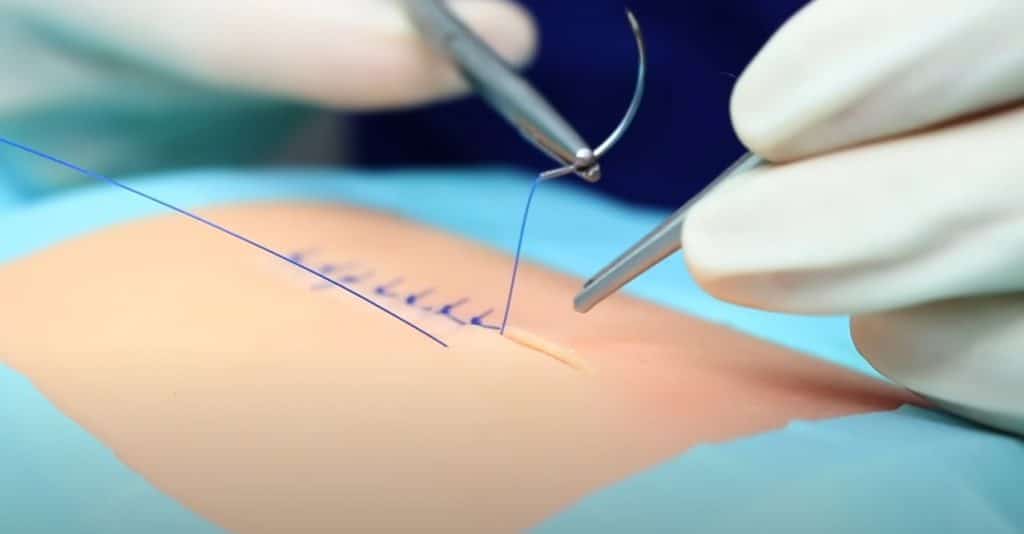
First of all, stitching wounds make for faster healing. If you don’t do your cuts and lacerations proper treatment like stitching, they will take a much longer time to heal and be of great discomfort. And even more, it is perilous.
And open wound – if not properly treated – is the source of possible complications. You don’t want any bacteria, viruses, or some sort of parasites to get inside your wound, do you? Because if they do, they will most likely cause blood infection or, medically speaking, sepsis. And this, in its turn, would result in a long and painful death.
So suturing wounds is very important. And in your everyday lives, if you happen to get a severe cut or laceration, you will want to get professional help at a medical clinic. But there are cases when doctors and hospitals are a luxury, and there is nowhere to get help from. And the only one you can rely on is yourself. That is the time when your survival and suturing skills come in handy.
Yes, we speak about survivalist situations – a war, a global-scale disaster, a post-apocalyptic future, or even just a regular hiking when there are no hospitals around. Our point here is that you must have a suture kit with you and know how to use suture tools to help yourself or someone from your company.
Get a high-quality medical suture kit in your bug-out-bag, try doing a lot of suture practice, and learn different suturing techniques. This, combined with a survivalist first aid kit, will give you an extra level of preparedness and self-confidence. Read this article to learn how to build a perfect first aid survival pack if you haven’t already.
How To Suture Human Skin

People have been suturing human flesh for nearly thirty thousand years already. So it’s no surprise that there are tons of various suturing techniques out there. So you may think that if even cavemen knew how to suture human skin, there is nothing too difficult about it. Well, not really.
Suturing is a medical procedure. And if you can stitch two pieces of cloth together, it does not mean you can do just the same with human flesh using medical suturing equipment like a surgical needle and a suture thread. So knowing how to suture human tissue and being able to do it properly takes a lot of suture practice. For instance, medical students and other surgical enthusiasts use special equipment for suture training.
A silicone suture pad is perfect for developing and improving suturing skills. A quality suture pad provides quite realistic human tissue simulation and lets students perform suture training and try new suturing techniques.
You also should know what kind of needle you need to use. Different wounds require different approaches and decisions. Skin thickness is another aspect worth considering. Our recommendation is to get a medical textbook that will take you through all the necessary steps of a suturing procedure.
However, if we forget about all the specific details of different suturing techniques for a moment, the basics of suturing a wound are the same. And here’s what you should do:
1 – Give the Wound a Proper Assessment
Before you start unpacking your latest generation model suture pack to get down with the business eagerly, try to give an adequate assessment of the wound you’re dealing with. Is it something you can handle here and now?
When making this step-by-step suture instruction, we came up with these simple points that might stop you from trying to suture yourself or anyone around you:
- The cut is too deep and wide. If that’s your case and you’re not sure that your suturing skills are enough to handle this task, then don’t. Try to get professional medical help.
- There is some object stuck in the wound, and you can’t seem to get it out. Trying to get a foreign object out of a cut or laceration may worsen the case. So it is best to try to seek professional assistance.
- There is massive bleeding from the wound. Massive bleeding will lead to excessive blood loss and death as a result. So your best bet is to deal with the bleeding first. Plus, too much blood will not let you perform a proper suturing procedure. Our recommendation is to try to stop the bleeding and get a professional doctor.
Although it is obvious, we cannot but stress it: a living human being is not a dummy for suture training, and a wound is not a suture training pad. So if you are not confident enough, or you think that you lack experience, don’t try to suture anyone on your own. Unless:
- You REALLY know how to do it;
- This is a do-or-die situation.
2 – Make Necessary Preparations
Make sure you have:
- Sterilized suture instruments. Use hydrogen peroxide or any other sterilizing solution from your first aid kit.
- I cleaned the wound with iodine. The wound must also be rinsed with saline solution.
- Fixed a needle to a suture thread. At the end of a thread, tie a knot.
- Prepared a needle holder to hold a needle steadily during the procedure.
- Given your patient anesthetics. If you don’t have any kind of painkillers, tell your patient that the procedure will be painful. Our recommendation is to find a stick and let the patient bite it down. This measure will prevent the patient from breaking the teeth during severe surges of pain.
Here is the complete list of the instruments you will need for the procedure:
- A needle and a thread;
- A Hegar needle holder;
- Adson forceps;
- Suture scissors.
3 – Proceed With Stitching
Suturing must always start with the cut’s edge that is the closest to the patient’s face. You must puncture the skin layer at approximately 6 mm. to the wound’s edge. While doing it, try not to cause bleeding. You must also make sure you are not loosening the stitch – it must be tight throughout the procedure.
Work your way steadily and go as deep as the cut itself with the needle puncturing the skin at a 90-degree angle. Don’t forget to hold the wound’s edges together, preventing them from opening wide.
Don’t use your fingers to grasp the needle. Always use forceps for that. Try to act gently and avoid causing extra traumas to the skin. When you’ve done, both sides of the cut should mirror each other.
4 – Tie the Knots
When suturing, you must tie a knot after each loop in a manner called “interrupted suture.” Although surgeons use special devices for tying knots in real life, it is unlikely that you would have anything of the sort during an emergency suturing procedure. So our recommendation is sticking with a regular square knot.
Once again: you must stitch every single loop. You can even tug them to make sure that the knots are tight enough.
Truth be told, under harsh survivalist conditions, it doesn’t matter what kind of knot you’re using as long as it allows you to fasten the cut shut and does not let it open.
5 – Sterilize & Bandage
When you’ve done, make sure to sterilize the freshly sealed wound. Infections are a danger, so don’t neglect this step!
Right after sterilizing the wound, use gauze and medical tape to bandage it. Remember to refresh the bandage and clean the wound every day until it has completely healed.
6 – Remove the Sutures
Removing stitches is the easiest part, but it also requires a certain amount of delicacy.
To remove the stitches, you should, first of all, wait for the wound to heal. Then you will need sharp scissors to cut the needle and tweezers to pull it out of the skin. But be careful – you don’t want to harm the freshly healed wound.
When the sutures are removed, wipe the stitch with alcohol and consider the job done.
For more details, watch the video below:
What is a Suture Kit?
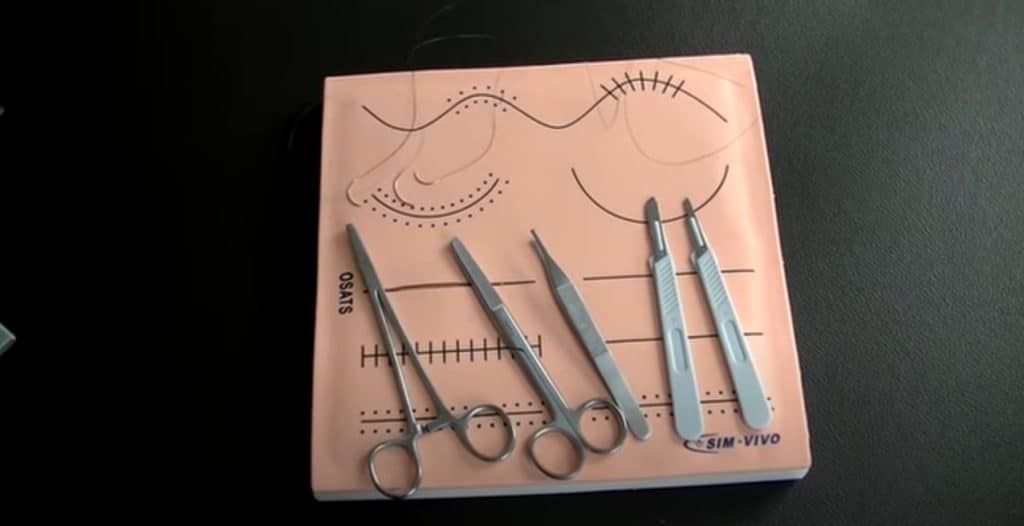
A suture kit is a medical sewing kit used to stitch up human tissue wounds like cuts and lacerations. Each suture kit includes instruments and items to treat open skin wounds.
Suture kits are featured in first aid sets of all emergency services. Paramedics, firefighters, the military – they all have suture kits and know how to use them. And, of course, we are sure that every prepper or survival enthusiast should have such a kit in their carry case, too.
A regular suture kit will have the following instruments in it:
- A needle holder;
- Forceps with a hook;
- Scissors;
- Suture material;
- A scalpel.
But, of course, there are various products on the market with different settings. Some products have items that other products lack. Read on to learn about our top five picks of the best suture practice kits on the market.
Alternative Suturing (no suture kit required)

Let’s picture this, you happened to get a cut or laceration, and you don’t have a suture kit at your disposal. What are your actions? You may be surprised, but there are at least two quite popular and effective ways to suture yourself with regular everyday items such as duct tape and super glue.
Duct Tape Suturing
We’ll be honest, duct-taping a cut or a laceration is hardly a medically approved measure. But if there isn’t anything more appropriate, duct tape will do just fine. But keep in mind that it is only a temporary measure. As soon as you gain access to medical supplies, remove the duct tape, and seal the injury using proper equipment.
Another important thing is not to cut off blood circulation while using duct tape. You may wrap it too tight around an injured limb, and that will lead to more serious complications. So be careful.
To cover an injury with duct tape, rip or cut the tape into short strips and place them over the cut, one next to another. Then take a cover these alternate duct tape stitches with a longer and wider stip of the tape to hold the smaller stitches together. Make the long duct tape strip run all through the length of the cut.
Super Glue Suturing
Gluing an injury with super glue is another alternative option if you don’t have suture equipment. This method reportedly met extensive use in the days of the Vietnam war. Unfortunately, suturing injuries with super glue did not pass the necessary standards to gain legitimate status in the United States. Many people were unsure if the superglue chemicals were safe to put into the human body through cuts. However, gluing wounds has become popular over the years.
A tube of super glue is, without a doubt, a must-have on every preppers checklist. It is a handy item in a first aid kit that can replace regular suturing if you don’t have access to the proper equipment.
Best Suture Kits Summary
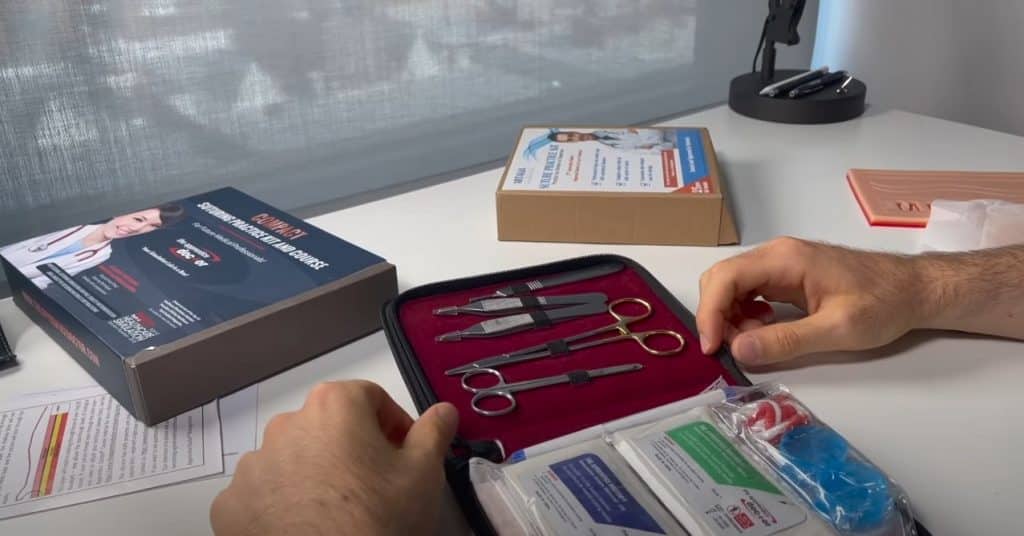
But buying such a kit is still not enough. You must know how to use all the tools in it. Learn how to stitch up human flesh, discover new suturing techniques, and practice as much as possible. After all, practice makes perfect. And if it comes to sewing someone’s cut or lacerated skin together, you will wish you were perfect. Take our word for it.
Frequently Asked Questions – FAQ
What is a Suture Kit?
A suture kit (or suture practice kit) is a collection of tools for suturing human tissue. Usually, such kits are portable cases containing such suturing instruments as surgical sutures, needles and needle drivers, scissors, and forceps. Often stitch kits will also contain scalpels with replaceable blades and related products like gloves and sterilizing equipment.
Another important thing a suture kit might have is a suture pad. Such pads are perfect for medical practice if you’re a student or just beginning to learn how to suture.
What is the Best Suture Practice Kit?
If you are looking for the best suture practice kit on the market, our recommendation is to choose between these five products.
- Feel free to visit each brand’s website using the links in the product description below.
1) Medical Creations suture practice kit. An easy-to-use option that is good both for a student and a regular customer – https://medicalcreations.net
2) A practice Kit by IkigaiTech. A simple solution with four types of sutures that will let you practice any kind of stitches. A good product for students – https://www.sutureskills.net
3) A Suture Skills practice kit packs some extra tools compared to most practice kits on the market. A great product for the price – https://www.sutureskills.net
4) A+ Medic is a trustworthy manufacturer, so you just can’t go wrong with their products – https://aplusmedics.com
5) A practice kit by Artagia Med is the most popular product students, preppers, and regular customers choose. Artagia Med is known for manufacturing high-quality kits for reasonable prices. The components of tools s are always of good quality as well. Another feature of the brand is that Artagia Med makes great use of clients’ feedback. For instance, while designing their second-generation model kit, Artagia Med took feedback from students to ensure the new kit will meet all necessary medical standards. Feel free to visit Artagia Med’s website for more details and product update – https://artagia.myshopify.com
What are the 3 Types of Sutures?
If you are new to suturing you should note that different kind of tissue repair requires different sutures. These types are:
- Polyglactin. These sutures are used for stitching lacerations on hands or a face.
- Poliglecaprone. Another name for thesу sutures is Monocryl. They are perfect for general soft tissue stitching. Most often, such sutures are used for making concealed stitches.
- Polydioxanone. These synthetic monofilament sutures are used for soft tissue suturing and cardiac procedures for children.
Can you Reuse Suture Pads?
A suture pad is a piece of silicone that imitates human tissue. A good quality pad must have three layers for maximum simulation: a skin layer, a fat layer, and a muscle layer. When practicing, students put stitches on the pad and then undo them to repeat the suture training procedure.
Suture practice pads can be reused up to a hundred times that way. But, of course, it will depend on the quality of the pad. When choosing a suture pad, pay attention to the ones that give the best human tissue impression, and offer maximum durability.
Here are some tips on how to choose a reusable practice pad:
- Make sure it has three layers;
- The pad must offer realistic human tissue appearance;
- It must provide a similar suturing experience as with real human tissue;
- The pad’s surface layer must not rip while suturing.
Where Can I Buy Suture Kits Locally?
Stitch kits are available online in multiple stores. You can search the web and find the store that suits you best to order a delivery to your location. Or you can search for an offline shop. Usually, you can find such equipment in military stores, survival gear shops, or medical supplies shops.



